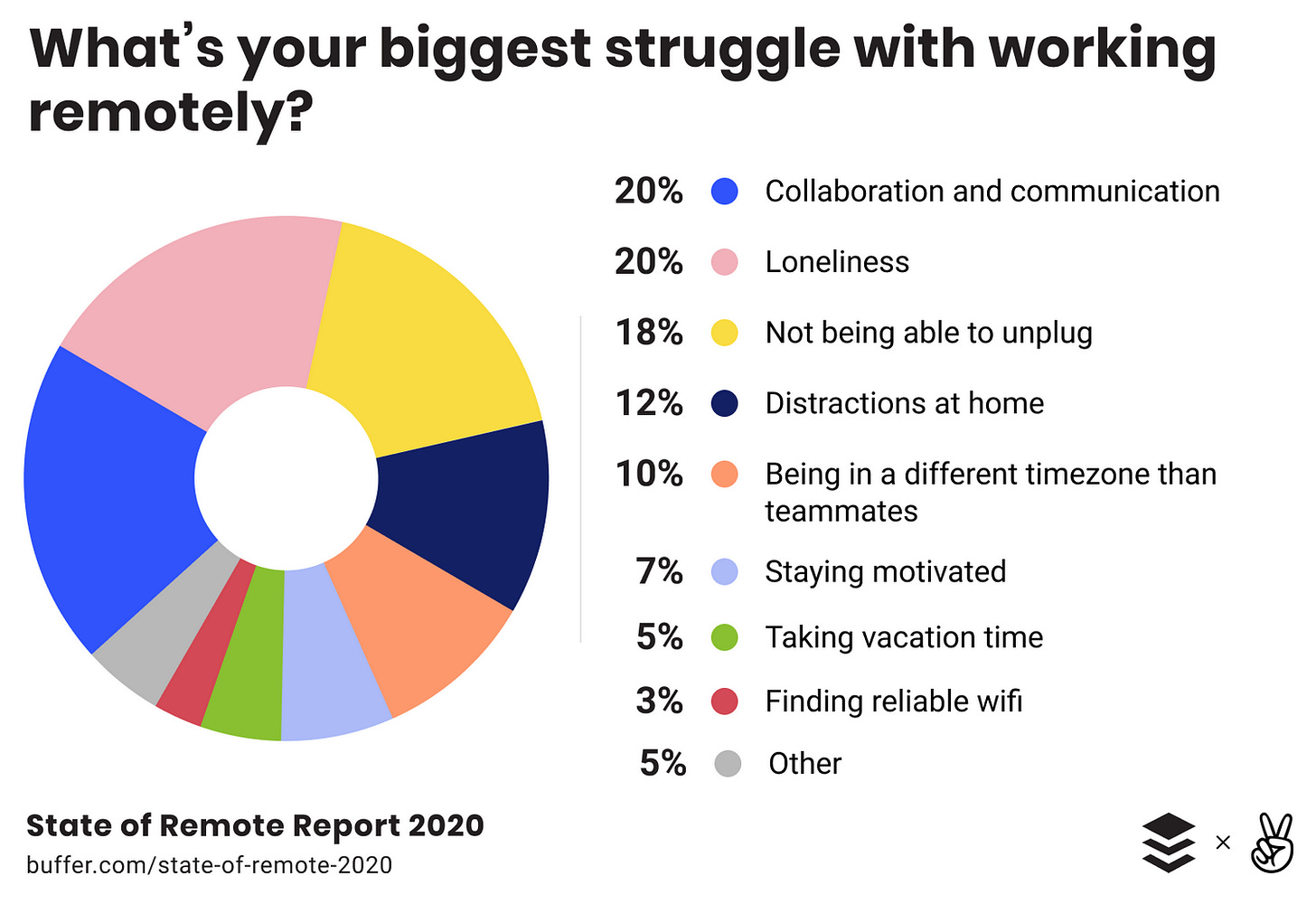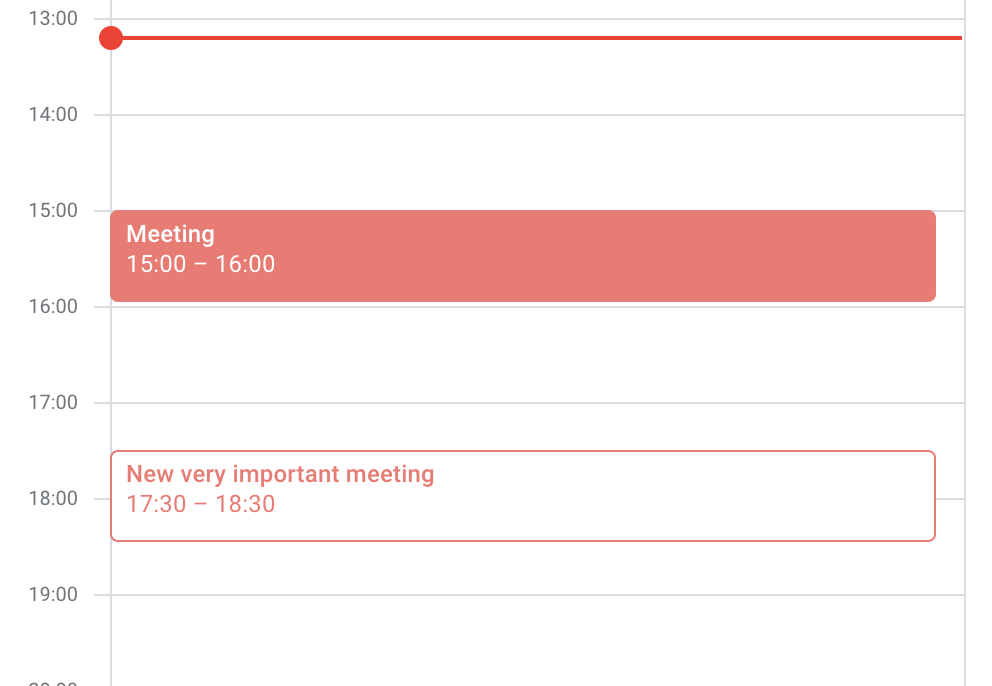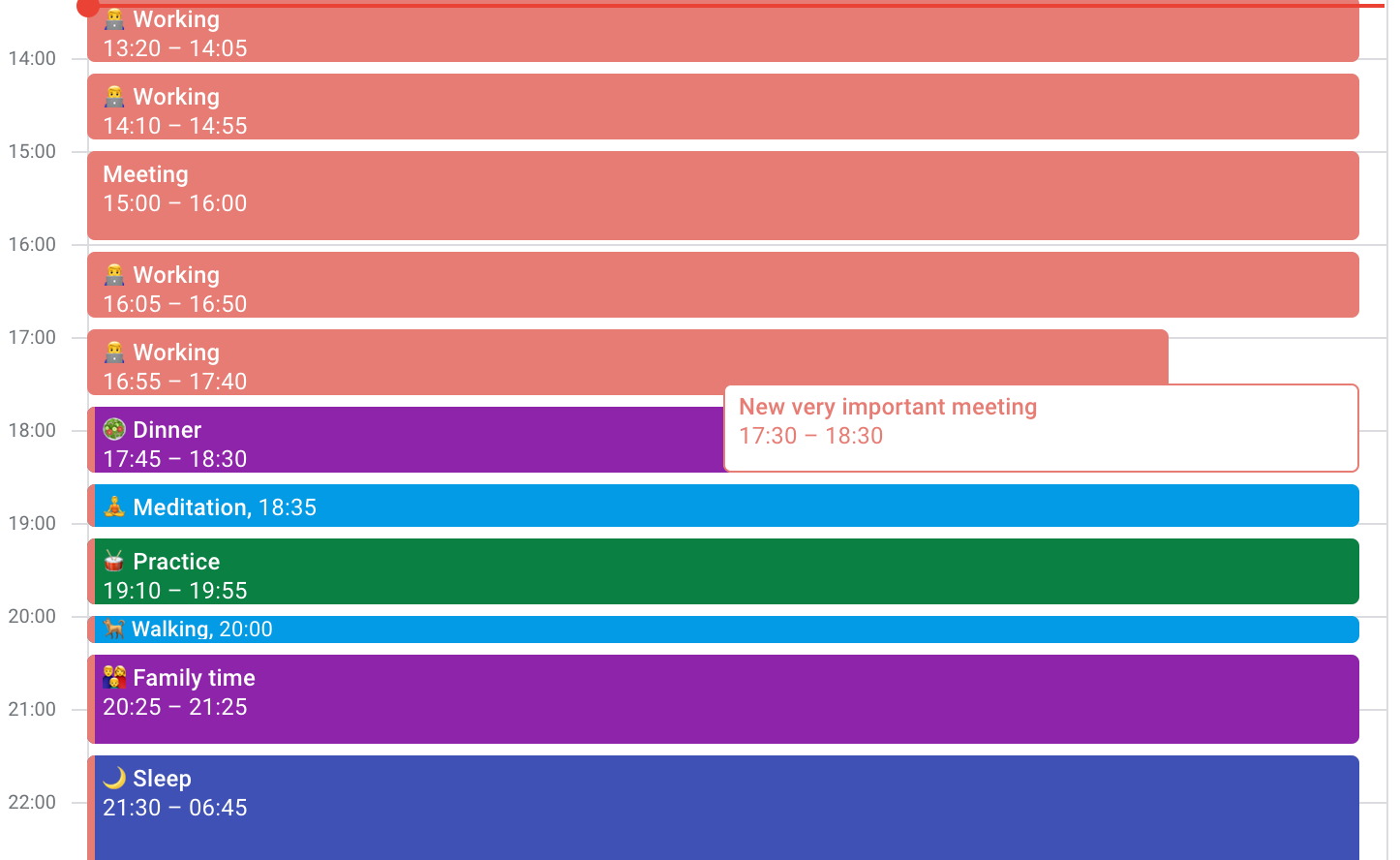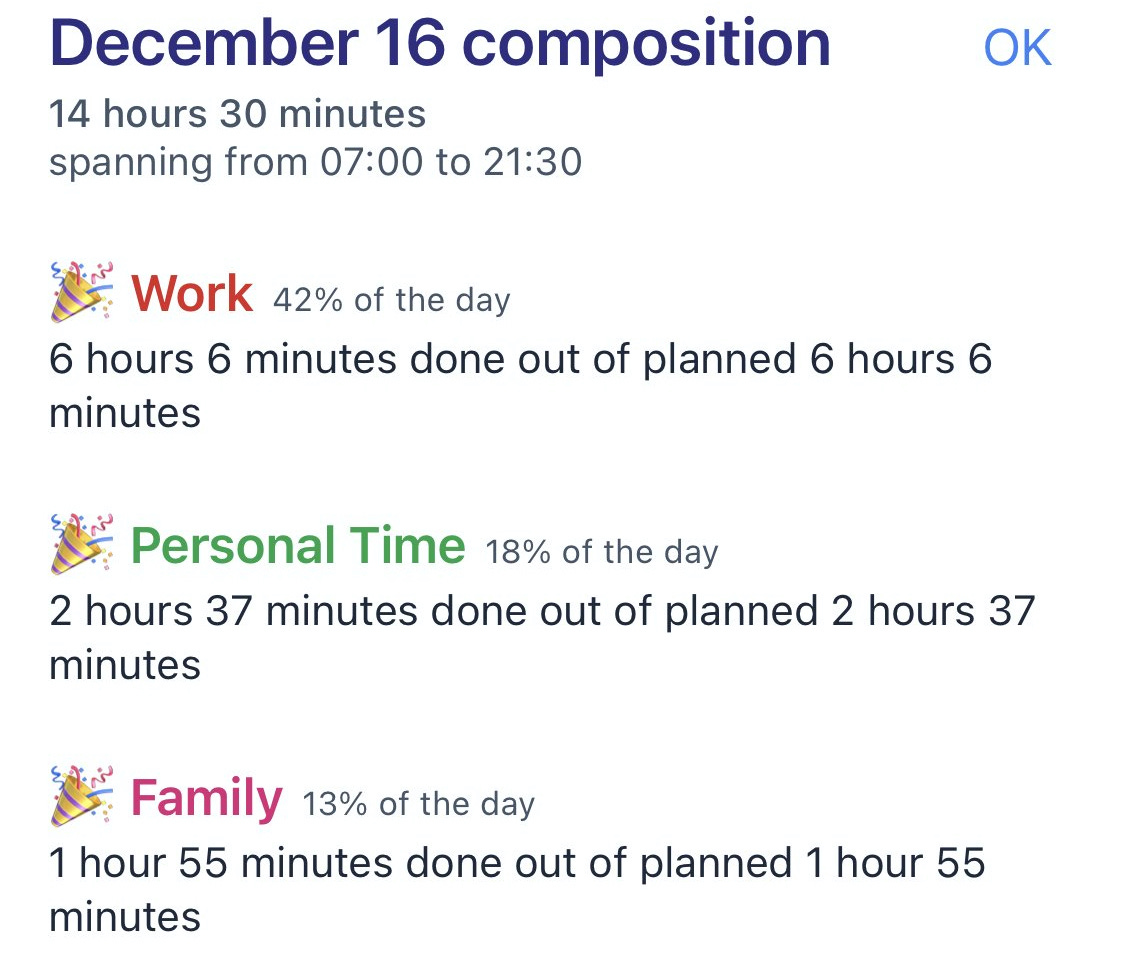Since the last March, like a lot of other people, I was forced to work remotely. It was not the first time, but somehow it went different. I quickly found out that not having a context switch between the office and home forced me into non-healthy behaviors like giving work all the available time.
The “normal” day could look like opening my laptop at 8-9 in the morning and leaving it only at 8-9 in the evening, saying “not today” to all hobbies, sport, and personal life. That was not scalable in the long run.
The latest reports on the remote work (that one from Buffer, for example) shows that I was not the only one. “Not being able to unplug” (read “I'm working or thinking about work all the time”) is almost on-par with loneliness and communication problems.
Since then, I’ve spent a lot of time tracking and categorizing my time, planning activities, and reading behavioral science research. All that trying to find the reason why I’m prioritizing work so quickly above everything else. And to find a way how to protect my life from that practice.
Plan explicitly and find the right triggers
The first rule that I came up with was so evident that it’s even a shame to mention. But still, it’s a cornerstone of everything: “plan all non-work things you want to do.”
Why? You usually commit to the outer side with work: you spend N-hours every day working or be penalized. On the other hand, there is usually zero commitment to life plans, except for a swift thought in the morning about how good it would be to go for a run today.
So, I’ve started explicitly making my plans: every morning creating a perfect list of things I want to do today:
home workout
drumming practice
having a proper dinner with my wife
meditate
start that one Coursera course, this time for real
It made some effect: at least every evening I was reminded how bad I’m at sticking to the morning plans. It looks like just filling a to-do list was not enough.
Why to-do lists don't work
I found the answer while reading about BJ Fogg’s behavior model:
It states that we do something when three factors are working together: ability, motivation, and something that triggers us to do that.
I could do everything from my list, and there was no problem with the motivation. So it looks like I lacked a trigger.
When observing a to-do list, the brain clearly understands that this is a list of things to do today. But “today” is a lousy trigger: 8 a.m. is “today,” 2 p.m. too, and even the whole evening is still considered “today” by your brain.
So that trigger does not trigger anything until it is dark outside, and you move today’s plans for tomorrow.
The solution was easy: planning time for each activity in the calendar. Then the trigger is obvious — the exact starting time.
Typically, the calendar would send you a notification about that plan, so you can start doing it or decide to continue working and move “home workout” once again. But at least it will be an intentional decision that you need to spend some brain cycles on.
There are two essential points, though:
I’ve started slowly adding only one item per day and controlling if I’m not overwhelmed. Cramming everything into one day from the start would be a recipe for disaster.
I wanted to minimize the amount of guilt that technique may bring to my life. So I’ve decided that the schedule I’m building is just a tool to help me navigate, not precise schematics. It should evolve with my day but not constrain it: I can replan at any moment or abandon it altogether. The only requirement that this should be an intentional decision, not something I would do on “auto-pilot.”
That worked like a miracle. I gradually planned more and more parts of my day. That liberated my brain from constant discussions with myself about what I should do next and if it’s really worth it.
So, in the end, I didn’t stop only on things from the list above and decided to crank the approach to the max: scheduling more or less the whole day in the calendar, even including sleep.
But there were some side-effects of that approach that I haven’t expected.
Building time awareness
The first side-effect was a clear awareness about what is suffering when I blindly agree to a meeting invitation that just hit my inbox.
When I had only work events in my calendar, I had a lot of “free” time, especially in the evenings. So there was no apparent reason to say “no” to that invite: look, your calendar says that you’re free.
But in reality, I was not: I had plans to spend that time on myself, with my family, or on sleep; it was just not explicit. So it was hard to understand the implications of that new meeting when your plans are only in your head.
Adding personal plans and sleep changed the picture. Every invite makes obvious the consequences of accepting it and forces me to decide how to handle the conflict based on the current priorities. Or maybe ask the colleague if we need to have that meeting.
Your day doesn't have 24 hours
If you open your calendar, it could give you the impression that you have all the time in the world: there is so much white (or darkish grey if you’re a fan of dark themes).
When you start planning your sleep in the calendar, you would have a stark revelation that days are way smaller, and so is the amount of white.
If you want to have recommended 8-9 hours of sleep per night, then you’re spending around 9-10 hours in bed, which means only having 14-15 hours in your day.
That visualization tricked my brain and made me question the quality of my time spending way more often throughout the day.
Also, having a clear understanding of what I should do now had an unexpected result of stopping procrastination. It is harder to explain to yourself why you’re on youtube right now when you’ve decided to start working, and the block has already begun.
Reflecting on the day structure
It’s easy to overestimate how much time you spend on whatever activity without having the hard numbers. Planning in the calendar allowed me to reflect on how I’m structuring my day in the percentage of the total non-sleeping time.
That shows if you’re really “walking the walk” and sticking to your priorities.
Also, it helps to spot some patterns. That way, I understood that having more than 40% of my day dedicated to work leaves me drained and tired by its end. As a result, I normally plan about 7-8 slots of 45 minutes (4-5 in the morning, 3-4 after lunch).
The important point here that by “work” I mean either focused work or being in a meeting, not the time when I’m just in front of the laptop or drifting around. If I feel stuck or distracted for some reason, it’s way more effective not to try to plow through but plan a short break or a walk. Then the solution will come to you naturally just in a couple of minutes after leaving the workplace.
It is also important to structure my work polyphasically: splitting the workday into 2-3 parts with a big break in between: lunch + longer walk, for example. Doing that, I could focus more and felt way better in the end. Remote work allows you to be creative with your schedule; it is great to use that perk.
But the worst surprise was seeing that sometimes I spend only 1% of the day working out while thinking of myself as a fit guy who trains a lot. 🤷♂️
Tools
The system is simple enough that you can implement it in any calendar app. But some things drove me mad about the amount of manual work they required:
When I plan my day, I think about the duration of blocks (like 45 minutes of working out). But the calendar forces me to think about the exact start time and placement first. That drains brain energy.
Changing things is tedious, too: if you start a block earlier or later, you need to move all the blocks below one by one manually. It’s even worse if you want to have some slack between them to avoid back-to-back.
Categorizing can be done by creating different calendars or colors: it would give you a good visualization of your day’s structure. But if you want numeric stats, you need to start summing up time manually or writing scripts.
The second point was the most painful one. As I said earlier, the plan should evolve with your day and support you, not be a restraining tool. So, from the beginning, I’ve decided that I should feel zero guilt changing it.
I was often adapting my schedule, and it generated a lot of manual overhead. In the end, I got the idea of extending the calendar with a new concept: time block. I fill in the name and the duration, and the calendar would be responsible for placing it into a non-occupied spot.
My daily schedule would be a list of those auto-placed blocks mixed with the classic calendar events (typically meetings). With that approach, I can spend no time creating the schedule, and what is more critical — painlessly replan if something changes.
Another important thing was the ability to add a category to every block and event. That allowed me to create stats for a day automatically, as shown in the screenshot above.
I did a prototype in a couple of weeks and liked the results. So I've decided to create a proper iOS app that would follow those ideas. Learn more about it.
Moving forward with time awareness
The primary metric that I’m optimizing for right now is the number of days that feel “worth it” by the end of it.
It’s easy to have this feeling when you achieved some breakthrough, got promoted, or some other good thing happened. But the goal here is to optimize for a different kind of day: when everything falls apart. If I manage to handle those, the “good” ones will be a no-brainer.
Building a skill of time awareness and some rules around it allowed me to isolate failures. Even if something terrible happens at work, having my routine preplanned helps me not to abandon it. And completing it makes that day bearable and protects me from going into the pit of despair.
Thank you for reading!
Please share your experience with time blocking in the comments, subscribe to receive new articles via email, or share with your friends if you feel like it!
But if not, then what about planning it for tomorrow?










Triggers are key! I think you will appreciate this “distraction detector” I built for myself just yesterday: https://davidbieber.com/snippets/2021-01-09-mobile-distraction-detection-at-last/
It uses Chrome’s synced tabs features to let me detect (and stage interventions) when I’m spending too much time on distracting websites on my phone.
Nicely written! Triggers are really missed out very often.
There is one point that I personally find worth to mention: when you exceed the planned timing slot.
I like to add an empt space slots to make sure I some reserve time and also to rest a little between and switch context more smoothly. What do you think about that?